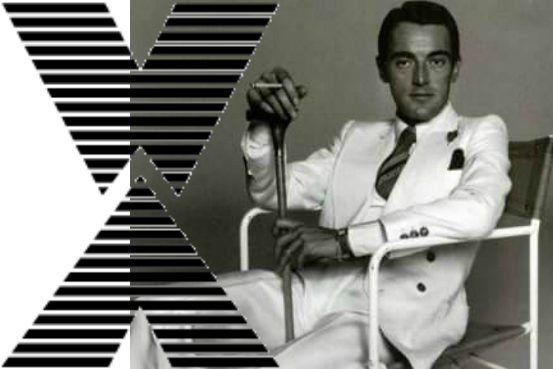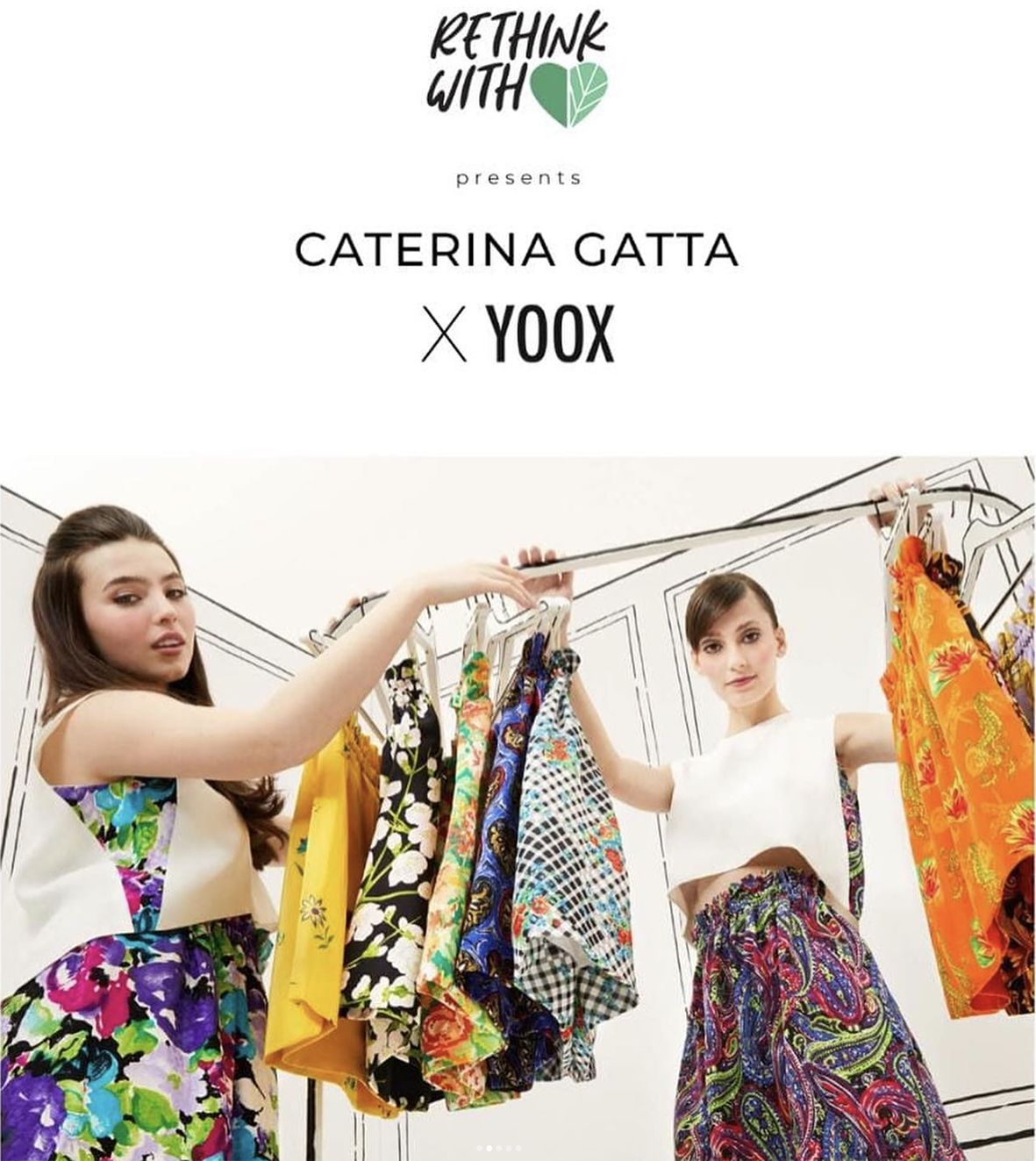a cura di Alessandro Martinelli
"Dress is a bit’ leave". WALTER ALBINI, l”Übermensch” (Forgot) of Italian Fashion.

We retrace the career of Walter Albini, dandy moody and full of contradictions, visionary in advance with the times. prototype of the designer superstar, It is the first to understand the importance of the brand and the designer name on the label with which unites different products, but also identification of name, immagine, logo graphic and face. Albini wearing her fashion and posing with celebrities in its advertising campaigns, anticipating an entire generation of Italian designers and not . It's "superman" loved and praised by total aesthetic vision (care of the designs of the clothes , the styling of the show, the advertising illustration and textile graphic), that knows no physical boundaries (He works in dozens of collections) but also economic, that will lead him and many businesses to bankruptcy.
Gualtiero (Walter) Albini was born 3 March 1941 and he resides in Busto Arsizio with family: the father, died prematurely, mother and brothers. It feeds from an early age a huge passion for the design of women's clothes so much that he abandoned his classical studies at sixteen to enroll in the Art Institute State for fashion design "Italo Cremona" in Turin, One boy in a school totally dominated by women. We are in the fifties, where the Italian fashion is still divided between low industrial production for the masses and high fashion for a few rich.
to illustrator Among his early works for the magazine "Mothers and Children", directed by Silvana Bernasconi, with which it collaborates for the "Corriere Lombardo" and "Vanity". Walter, at the suggestion of Gigliola Curiel, he went to Paris between 1961 and the 1964 to perfect his technique and work for the stylist agency Maime Arnodin and Denise Fayolle, for which realizes maquette for fabrics; it is then that he was dazzled by the now elderly Coco Chanel: its timeless elegance will become a constant reference point in its fashion. The return home is related to the magic and the Alps fortuitous meeting with Mariuccia Mandelli, for which to care 1968 the line Krizia Maglia, last season alongside a Karl Lagerfeld its infancy. Albini began a number of experiences of collaboration and consulting with companies and boutique attentive to the young audience.: in 1963 It created her first collection for Gianni Baldini, contemporaneamente, as early as the mid-sixties, He collaborates with a large number of shops and packaging companies like Billy Ball, Cadette, Trell, Montedoro, Princess Luciana, Paola Signorini, Uama Sport, Cole of California, Annaspina, Glans, Callaghan.

Its rapid success grows thanks cover correct design system able to provide all relevant information to the construction of a total look and full understanding of the needs of the consumer, offering different styles to choose from. Nel 1970, designs for the new boutique in Milan Misterfox the Venetian young industrialist Luciano Papini, imagining clothes for mature women at affordable prices.
the designer, progressively, become a link between the needs of industrial production and consumer, working together for several companies offering a different style for each and intended to equally different market choices. The current agreement with Papini, however, excludes the publicizing of the name of the designer on the label, which limits the continuity of the image . His interest also covers the textile design for fashion and furnishings (especially with Etro, for the production of his famous printed fabrics) and participates in events such as "Ideacomo", "Comofoulard" and to those relating to the Protection Center Lino.Nel '69 Albini participates with Alberto Lattuada, Miguel Cruz and Karl Lagerfeld at the event Idea As, promoted by the Italian Manufacturers Serici, with the aim of presenting, finally, with unity of style and colors, textile production for the summer 1970. In the same year Albini suggests for Montedoro uni-max formula, even cut and color for men and women. Pitti Woman, in 1970, receives a discrete success to the press his collection "Registry for Misterfox", memorable thanks to the eight wives in pink and eight widows in black, gowns based on tunics overlaps in different materials and lengths, decorated with beads and inspired by the Twenties: questo, purtroppo, does not guarantee financial success (due to the poor visibility of collections at Pitti Woman) and the collection remains virtually unsold.
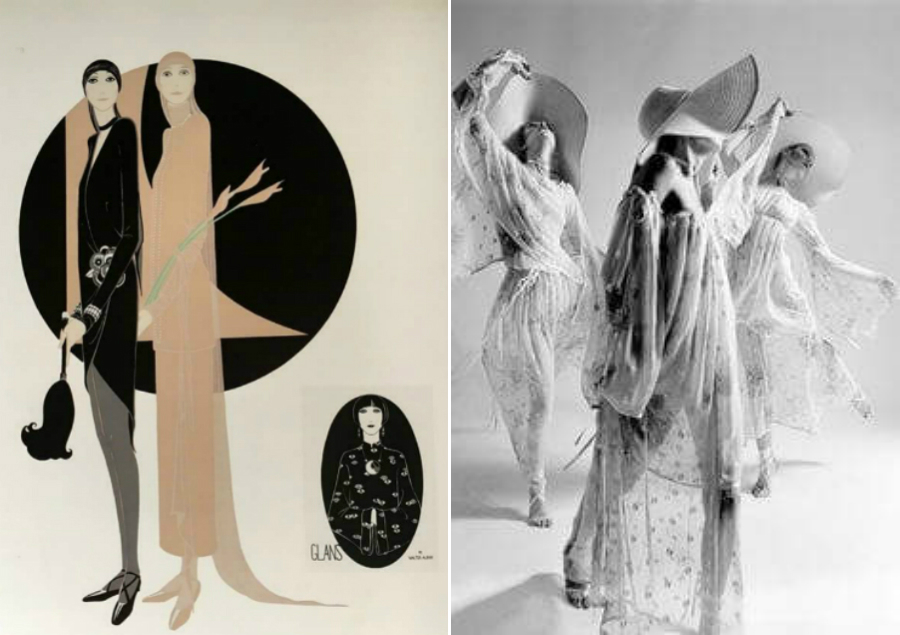
always Misterfox, the following season, draws a Pre-Raphaelite collection ", presented to Maremoda Capri, the romantic line and pastel colors, with loose clothing and cover-ups ankle which leave the shoulders bare, and a collection called "Rendez-vous", presented at Pitti, with printed fabrics and many pop embroideries are juxtaposed and where different lengths and the layers terminate at the tip ( jewelry and handbags are the young Ferré). Capri and Florence, where Albini slips with intended creations and different labels until 1965, then are the capitals of taste as well as international tourist destinations, Albini but laments the need to give a denomination to the collection, It made impossible due to the lack of coordination between the textile industry and the production of clothing, but also too rigid formulation of presentation, organized according to a precise number of animals to be paraded before the public.
In spring 1971 a group of fashion designers such as Ken Scott, Albini and Cadette, who will join Caumont, Krizia and Missoni decided to present their collections in Milan at the Garden Club, thus sanctioning the birth of ready–at–porter italiano.

In a single parade, Albini presents the collections of five fashion houses ( Basile for outerwear and trousers, snails for knitwear, Callaghan for jersey, Misterfox for clothes , Diamant’s for shirts, replaced later by Sportfox), is labeled with the name of the producer with that of the designer, for which he designed garments totally coordinated from morning to evening, creating the first examples of “total look”: the collections are produced and distributed by FTM Ferrante, Tosetti and Monti, Company forefront of experimentation of a new textile industry management through the direct management of the companies involved in fashion production. The designer thus becomes the figure to be proposed as a model and its increasing notoriety far exceeds that of the industries for which it collaborates.
They appear more heads on the catwalk and the designer introduces first the music instead of the speaker, where style and image are moving hand in hand. The A / W collection 1971-72, It is a huge success, a print triumph and buyers. style unit, different relationship with tessutai but above all the knowledge that the High Fashion, as it was understood in the 50s, It is now going to disappear to make room for new production models, in particular the need for a different conception of the relationship between design and production. Milan is in fact not only close to the textile industries, but also to the factories of machines and tools. The new fashion design system it also requires rethinking and reinvention of acts machinery to produce it. With the A / W collection 1971-72 Albini also invents a new way to advertise, only with the drawings, affirming the concept of "groupage" on magazines. They are the suppliers who pay the pages, not the fashion houses or fashion designer.

In the same year, at the Garden Club, It presents the next collection, P / E 1972, known as "Flags" or "The Marinarette", where male and female models wearing sailor hats and the sailor recalls are many. The dominant colors are black, il bianco, the Red, blue and yellow, with blue tips about the sea in Tunisia. Prints on both flags for shirts and for dresses, knitting colored striped, ruffles everywhere. Some pants are worn without top, while the foot espadrilles for men and women.
The project has been going on for two more seasons, and the autumn / winter collection 1972-1973, inspired by Marlene Dietrich and numerous references to Chanel and Schiaparelli, It remains a cornerstone of the Made in Italy: the international press called Albini "strong as Saint Laurent". The press release begins with the phrase "High fashion is dead, high fashion alive ": two hundred rich and luxurious garments, extremely varied, With Fox Hills, pied-de-poule, Velluto a lamé. The complexity of the collection makes it difficult distribution, some leaders do not enter into production and after some initial friction, the association with FTM ends.
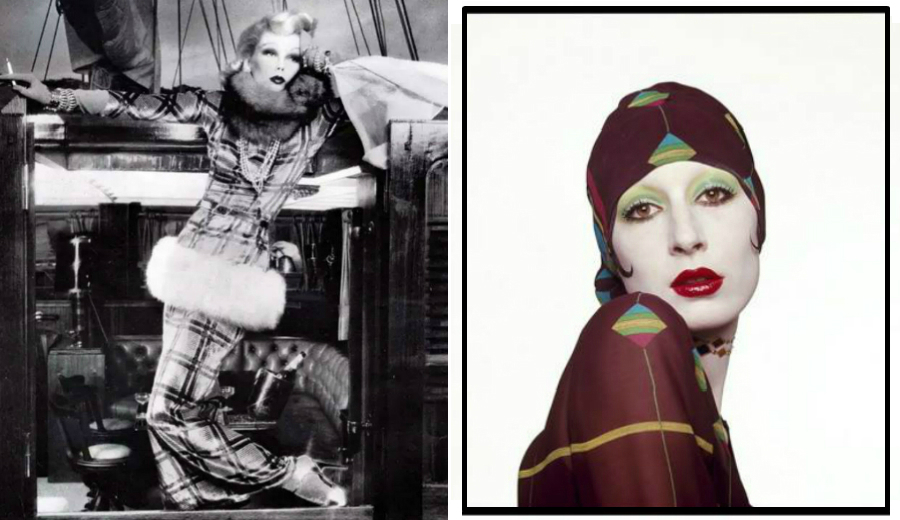
With the spring-summer 1973, comes the first line "Walter Albini", Graphics WA whose label is inspired by the Wiener Werkstätte: it is produced and distributed by Papini, for which continues to draw Misterfox (which becomes a second line) until 1974.With the help of Mrs.. Joan Burnstein, owner of Browns, He is show in London at the Blakes Hotel, 6 men's suits and 27 Women and christens this collection with the title of great Gatsby, the novel of one of his heroes, Scott Fitzgerald. The parade is an opportunity to create that unstructured jacket, the jacket-shirt, that will be so important to the future of the entire Italian fashion: It envelops the models in clouds of chiffons and lace mechanical Etro floral print, while for men both blue and white. This is the first time it is adopted the formula, that much imitated, a first strong image line driving, restricted sales, financially supported by a second collection easier, for the big number.Nel 1973 It opens its showroom in via Pietro Cossa, where does pull the Misterfox collection: clothes from the line straight, decorated reason Klimt obtained through the contrast of satin inserts on cracks, and held by jewel belts satin and rhinestones.

He takes home in Venice, where ambienta, Florian Coffee, a memorable parade for the collection WA, A/I 1973-74, where models carry the doges names and dogesse and are accompanied by a small orchestra of St. Mark's Square he plays waltz and tango. The parade opens with six wives, Then a parade of models from the black bob and gardenia in your hair (the men wear feather) and pearls.The Venetian house, sul Canal Grande, a few steps from the Peggy Guggenheim Museum, is defined by Isa Vercelloni "the enchanted zoo Walter Albini": glass beads Murano and three walls all the same as the floor and ceiling. In the middle of the atrium a marble black panther, beyond the curtain a fully magazines dining room of a mosaic of mirrors. constantly he was returning the theme of murrine, printed on cards and objects, or on pillows fabrics. "With enthusiasm, not without irony, personally he oversaw the decoration of this his Venetian house, designing some pieces, intervening on other, Gold painting roses and lions and even upholstery, collecting artificial plants (the palm trees are plastic) and ceramic beasts for an enchanted zoo and deliberately spectacular, where marble also is plastic and oriental rugs are printed on cotton " (Casa Vogue, July August 1973).
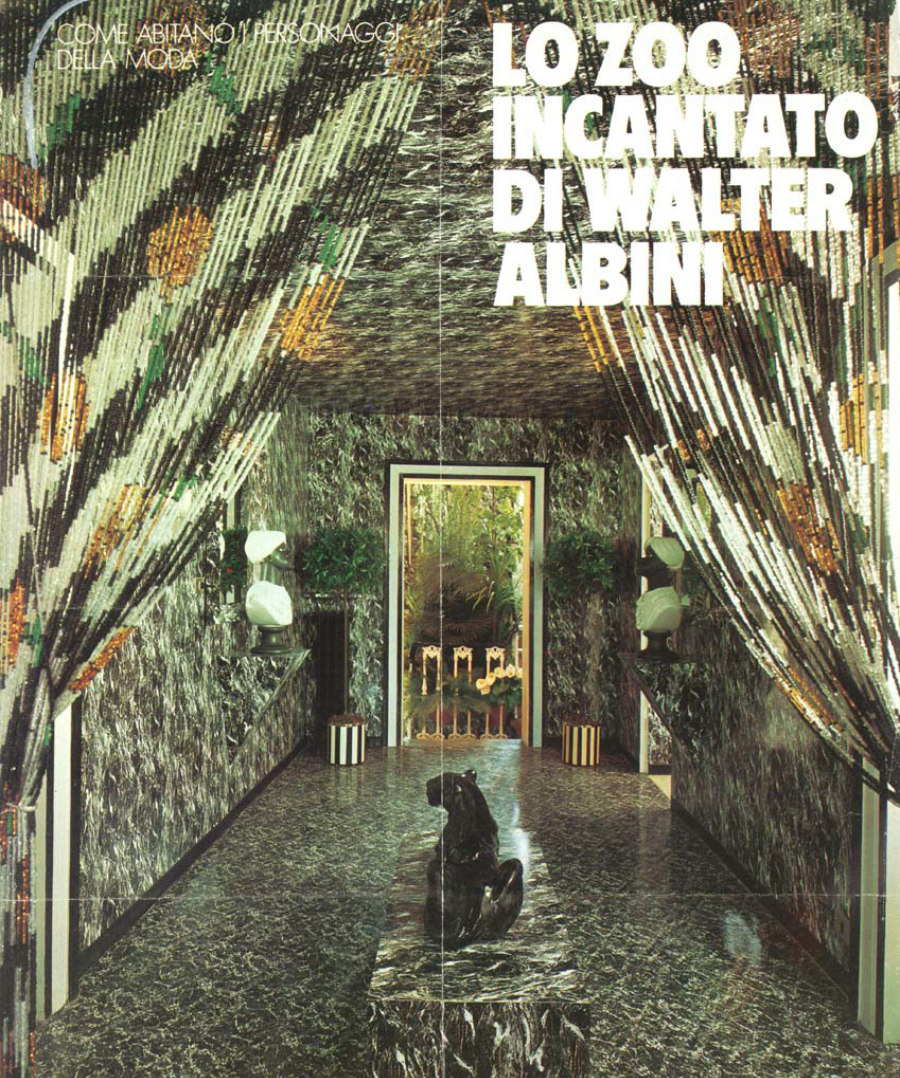
Nel frattempo, born the character "Walter Albini", acclaimed by the press for its old-world elegance inspired by Chanel and Poiret, often compared to Karl Lagerfeld for his eclectic side and histrionic. Non-Case, that of Venice and that of Sidi-Bou-Said (former Andalusia Arab village not far from Tunis), at ease from the Decaden, even more define its aura and become a natural backdrop for photo shoots monsters.
In an interview at that time, he claims:
"I like the period from 1925 al 1935 because I think it was the decade in which all aspects of human life have been revolutionized.. Just think about the haircut bobbing, skirts that are shorter and the elimination of corsets. O a Francis Scott Fitzgerald e a Zelda, the first Garbo and Dietrich, Bauhaus and Art Deco. The change in music, in the dance, in painting, architecture and lifestyles were momentous and spread to the point that today we live in the outcomes of those experiences ".
Due to the lack of a real organizational and business support, il 1974 and the 1975 have years of crisis, although the creations of those years show a unique refinement, made of exoticism in "paisley" printed fabrics that comes from her many trips cues in the East, India mainly. The spring / summer collection 1974, presented in Rome at the Salone Margherita, He recalls the early forties: peeps here for the first time the famous fabric "Murrine" along with silks printed borsi "paisley" and regularly spotted backgrounds.
Although the menswear entered in the aesthetics of Albini at the end of the Sixties with UAMA Sport and Montedoro, It is in the 1974, the salon Pierlombardo, which creates an all-male collection; in parallel, It founded the ephemeral project ( only a year) high fashion. In January and July 1975, Nurseries in the South of Rome, off calendar shows respectively his collection Spring-Summer and Autumn-Winter, both made from tailoring Dogle Fare and in collaboration with Joseph the Slave, which realizes thirst printed on Albini drawings. It proposes the concept of atelier clothes to sell in "sliver".
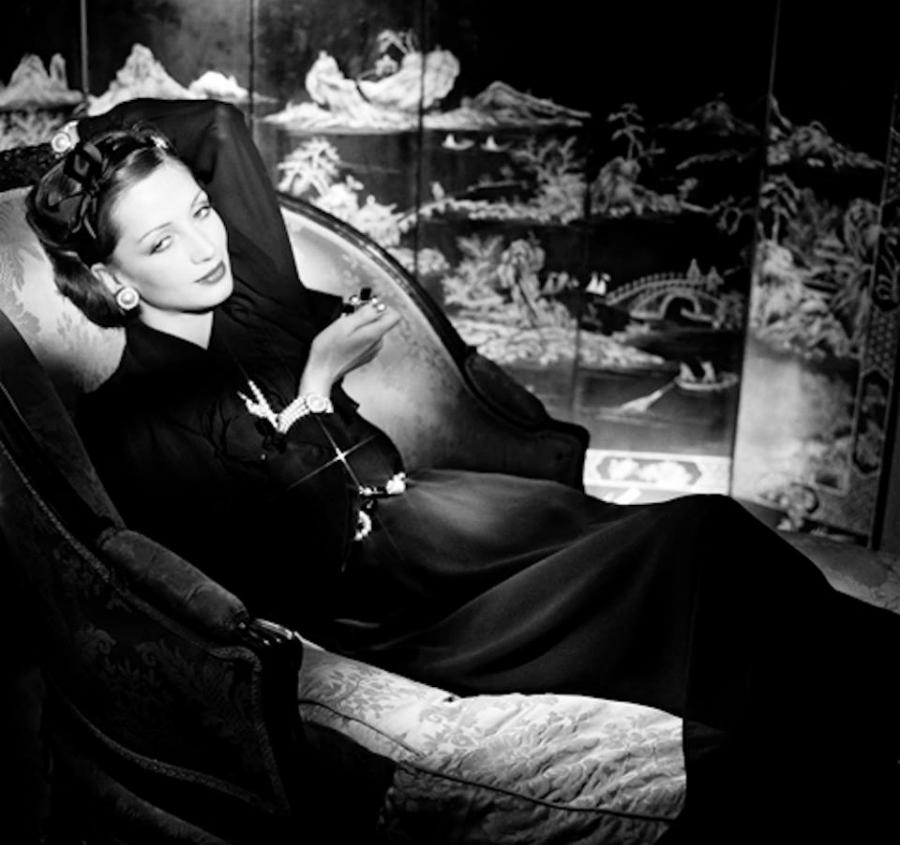
The EP Collection 1975 It is inspired by Chanel and years 30, the next collection, that pays homage to Paul Poiret, It is a riot of pink ( "A rose of dampened the fall in the gray or darkened by certain brown blush", as defined Isa Vercelloni), underscored by soundtrack, which includes dozens of different versions of "La Vie en rose".
Dal 1975 al 1976 collaborates with Trell and "Hollywood" style of the early seventies is progressively substitute by a new fondness for his interest shifts to the Russian avant-garde and recreates the working uniform starting from Rodchenko and drawings by Sonia Delaunay. Laying the exit of a factory, wearing balaclavas of extremist movements of the years of lead, a stylized variant dell'eschimo and pants tucked into boots, precursors of modern amphibians "grunge" (collection "Urban Guerrilla Trell for" F / 1976-1977). In the chic dell'hippy , Albini takes pictures like a modern Siddhartha, seated in the lotus position on top of a mountain of colorful clothes, in ethnic fabrics, righe, iktat, flowers for the collection "Indiana" for Trell (P / E 1977). In another snap walking in a tunnel of clothes by Indian colors flying and surround him.
The interest is focused on the search for simplicity, realizing draped garments without cutting or sewing, that allow the wearer to interpret them in a different way. The collection is presented in a happening without default outputs, with soundtrack by Daniela Morera.The love for the folk typical of those years (think of the collection "Ballets Russes" YSL) infects the spring / summer collection 1978 per Trell, where each model is dedicated to a woman of fashion, with Tunisian echoes, Serbia, Mexican and Fortuny recalls. The clothes are modeled on the body by means of nodes be draped by drawstring, they have very few seams and often lead overlaid.
Isa Vercelloni and Flavio Lucchini Albini attribute to "the ability to dream, the ability to give shape or a semblance of reality to his dream world. It even has the rare ability to do so without damaging them. This is the reason why women love so much her clothes. They immediately recognize that it gives power to the imagination ".

Due to economic difficulties related to the abandonment of the atelier of Via Cossa, He sells his house and moved into a high-tech apartment in Milan in Piazza Borromeo: a casting of gray fills all the space, spare and unadorned, on the walls and floors of resin. Metal cabinets and aluminum chairs, lamps stolen some small factories Brianza, numerous portraits of the landlord, true narcissus.
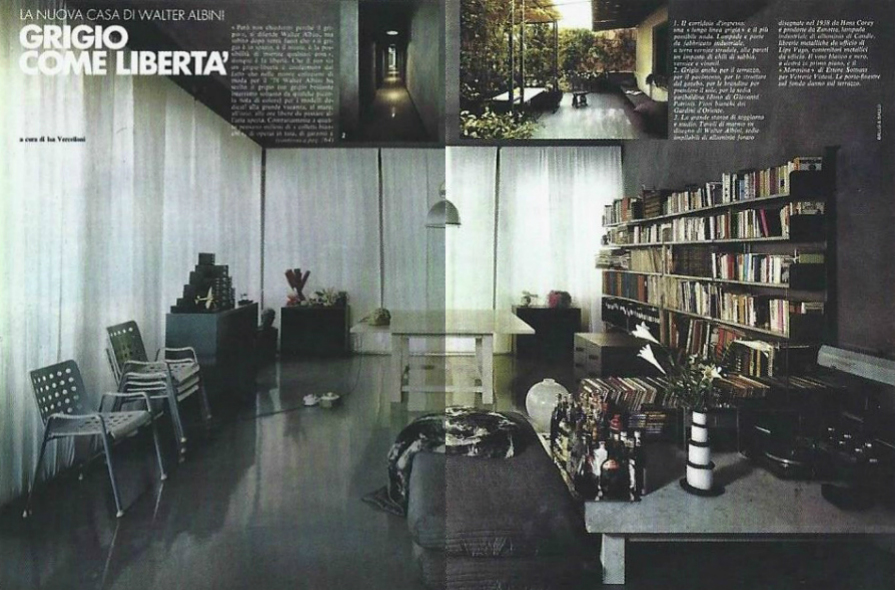
"Master of the artificial nature", as defined by Anna Piaggi, in the second half of the seventies he made a series of events that test new ways of communicating fashion and brand: in March 1975, presents the restaurant Angolo di Milano her winter collection, using friends as models and friends reiterating the unisex character of its leaders and letting them play characters from the history of opera. Guido Cegani, His photo shop, is, for example Figaro; Edy Vincenzini, only woman and a professional model, wearing men's suits and plays the double Stylist. Walter Albini takes on the role of the Duke of Mantua.
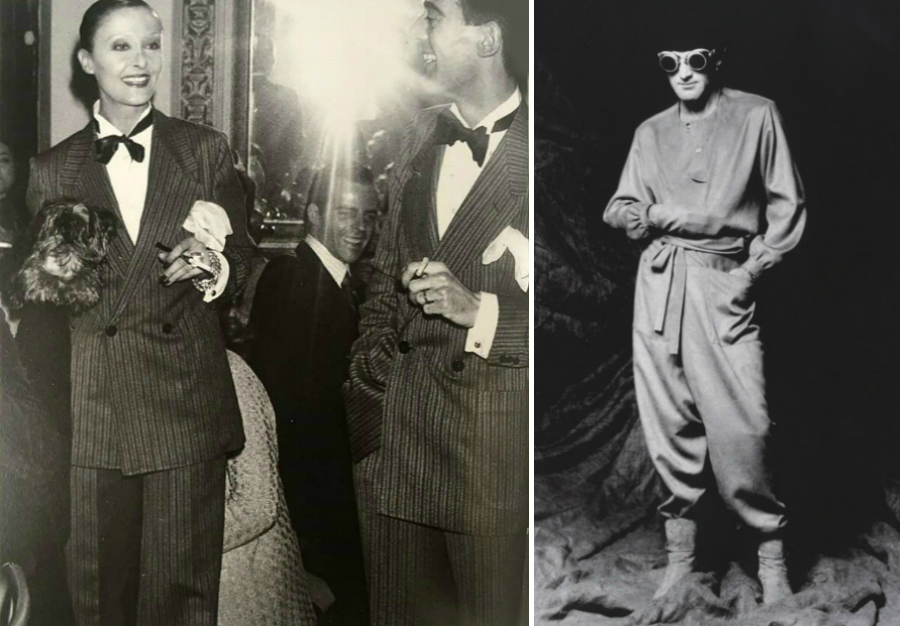
In October 1975, Fiorucci in the new restaurant, uses as models portrait busts beige or blacks; in March 1976, He is portraying twelve photographer friends as the only model "Dress is a bit’ leave". The images do not document the dress, create a "mood", a vision, a reading of the trip: panels, made by Albini to bind to each design of the collection a photographer, with Polaroid that complement the outfit, becomes the surface on which to build the characters to be interpreted to turn every head in a travel idea. In October 1976. at Anselmino Gallery, It presents its "no collection", collage of "robes trouvées" compounds with original heads of Basile, Armani, Fiorucci, Krizia, Missoni, Miyake, etc…, crowned by the cast of his face.
A proposito, Albini says: “What interests me is to give indications of the method, both drawing using other people's things, as I did here. You have to learn the freedom to dress out of any scheme. Consumerism produces objects , no styles. I look around, I choose, Combine and propose”.
In March 1977, at Eros Gallery, organizes an exhibition of fouls symbolizing celebrities.After breaking contact with Trell, It reopens a brief association with the FTM for the production of the collection autumn-winter Walter Albini 1978-1979, that will last until summer 1980. Presented at the Museum Parmanente, the collection, a refined cut and the folk elements of Balkan and oriental inspiration, It is a great success, as the next, the Rotonda della Besana. After the parade for the A / W 1979/80, the relationship ended abruptly.

Contemporaneamente, signing an agreement with Lanerossi which will have no positive results and will give rise to a cause that will continue even after his death. The agreement provides for the strengthening of Walter Albini and creating Arlanda, second line, with which slips at Pitti New Signatures with spring-summer collections 1980 and autumn-winter 1980/81. Since March 1979, It adheres to Modit and subsequently begins a collaboration with the spinning Lane Grawitz: new knitwear lines are presented at Pitti Filati until the death of the designer.

In the eighties, the press has little interest to him and, therefore he dedicated to other projects: the illustration of a book of poems in Raffaele Carrieri 1980 and creating a costume for the piéce 1984 Ronconi. Restart the collaboration with outside companies as Pep Rose, who commissioned two different lines, Vevera e Pep Rose Over, by Hamilton, second line Cadette. It appropriates of the camp culture stereotypes of the early eighties and takes pictures with a t-shirt with zodiac signs and Venetian masks, along with the model Isa Stoppi.

His health deteriorated rapidly and, hospitalized at the clinic "La Madonnina" in Milan, dies 31 Maggio 1983 . In one of the last interviews, He describes the woman who would like to dress : is the image of that woman co-starred with the man who draws Albini and anticipates the post-modern elegance of the 80s a whole generation of designers, first of Giorgio Armani.
"I just made the description of the woman who would like to dress… thirty, thirty-five years of… thin but solid bone structure. straight and wide shoulders. long Bust, narrow hips, little breast. small Head, medium length hair tending to short. Do not over sports, but with the appearance of those who practice sports. ambiguous, tough and strong at least in appearance. Heavy smoker, traveling, It is not necessarily married. Work, but it seems perpetually on vacation. It has style, Elegant, mysterious, alone, adaptable but not coinvolgibile. Not necessarily beautiful, but surely irresistible ".

The alphabet "Walter Albini"
A as "30 Years"
B as "shorts"
C come “Coco Chanel”, but also as "Russian Constructivism"
D come “dandy”.
And as "Etro", with whom he collaborated for the creation of a number of printed fabrics for furniture and clothing.
F as "Fashion show", and all changes made to the presentation, from the top of the music volume, the use of unusual locations, from the vision of the parade as a representation.
G as "groupage" or "urban guerrilla"
H come “happening”, or typical presentation of the second half of the seventies.
K as "Krizia"
I like "Italian".
L as "Liberty"
M as "Milan" and as "Misterfox"
N as "Birth of the ready-to-wear Italian"
Or as "East" and thousands of suggestions of his travels.
P as "ski mask" but also as "Paul Poiret"
Q as "paintings", ie printed geometric, "Goose-foot", "Prince of Galles, etc…
R come revival, expression of an intelligent form of research and reinvention.
S as sexuality and sensuality.
T come total look, from head to toe all coordinated.
U come “unisex”
V as "Venezia", seat of the famous parade at Café Florian.
W come "Wiener Werkstätte"
Z come "Zeitgeist", man to breathe the air of time and precorrerla.

